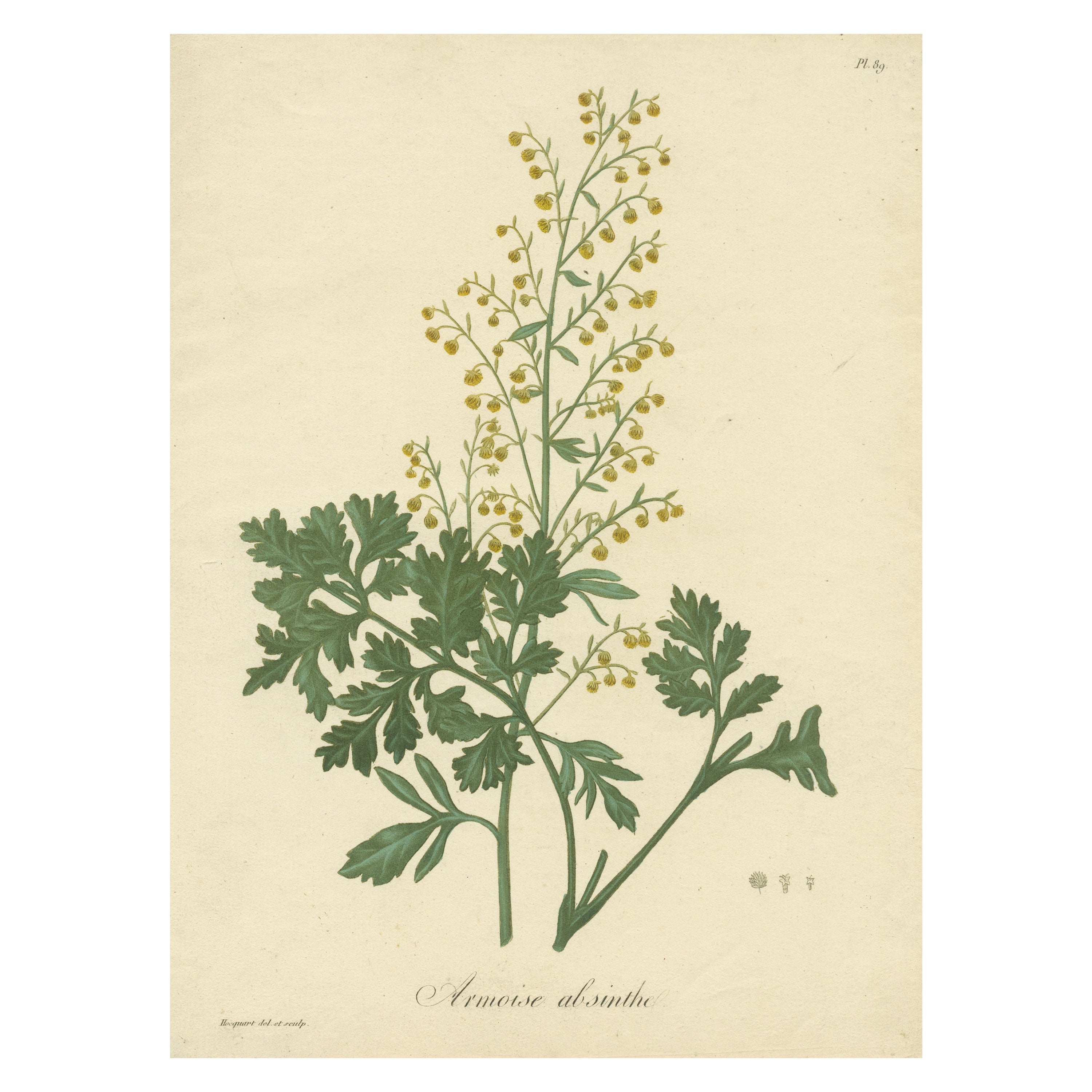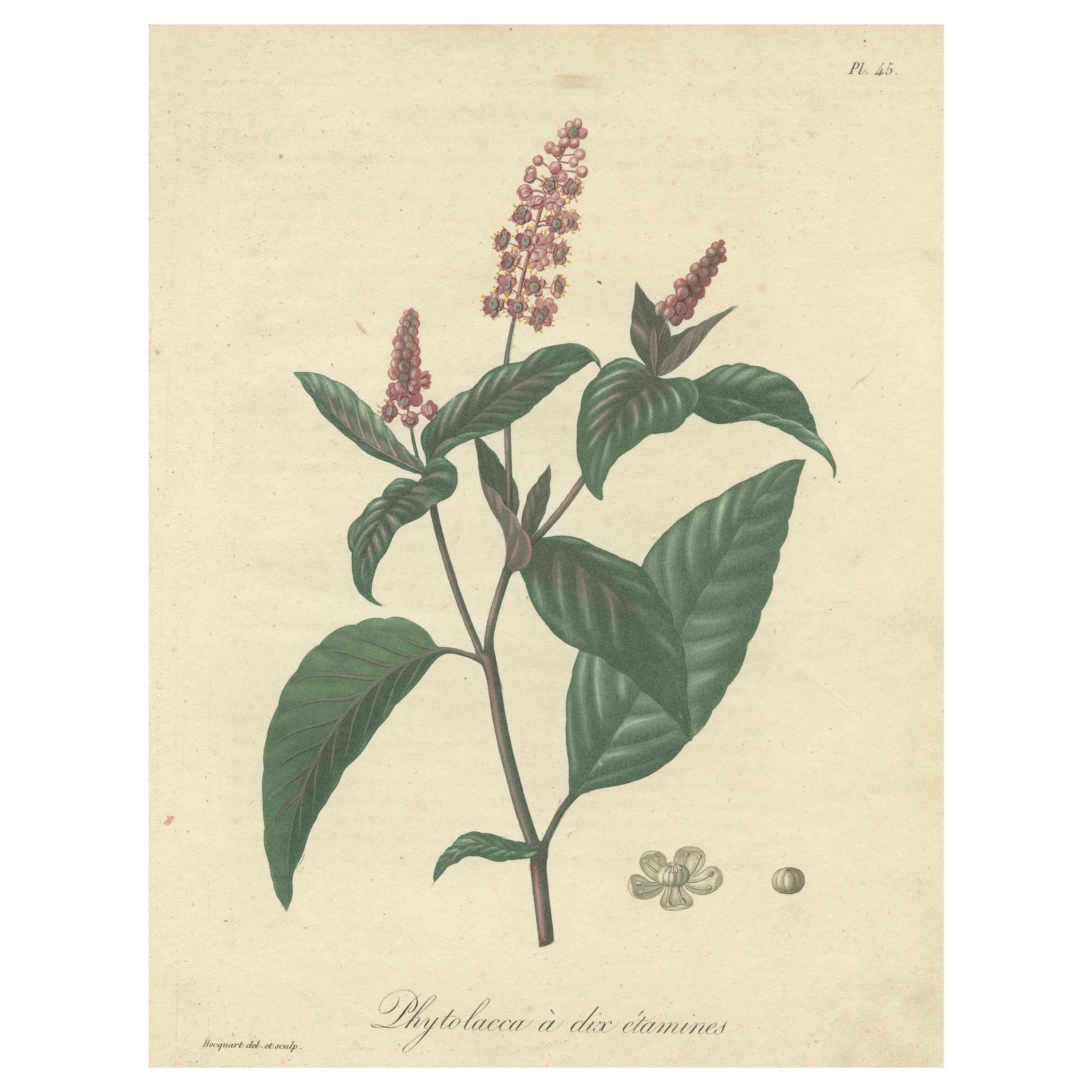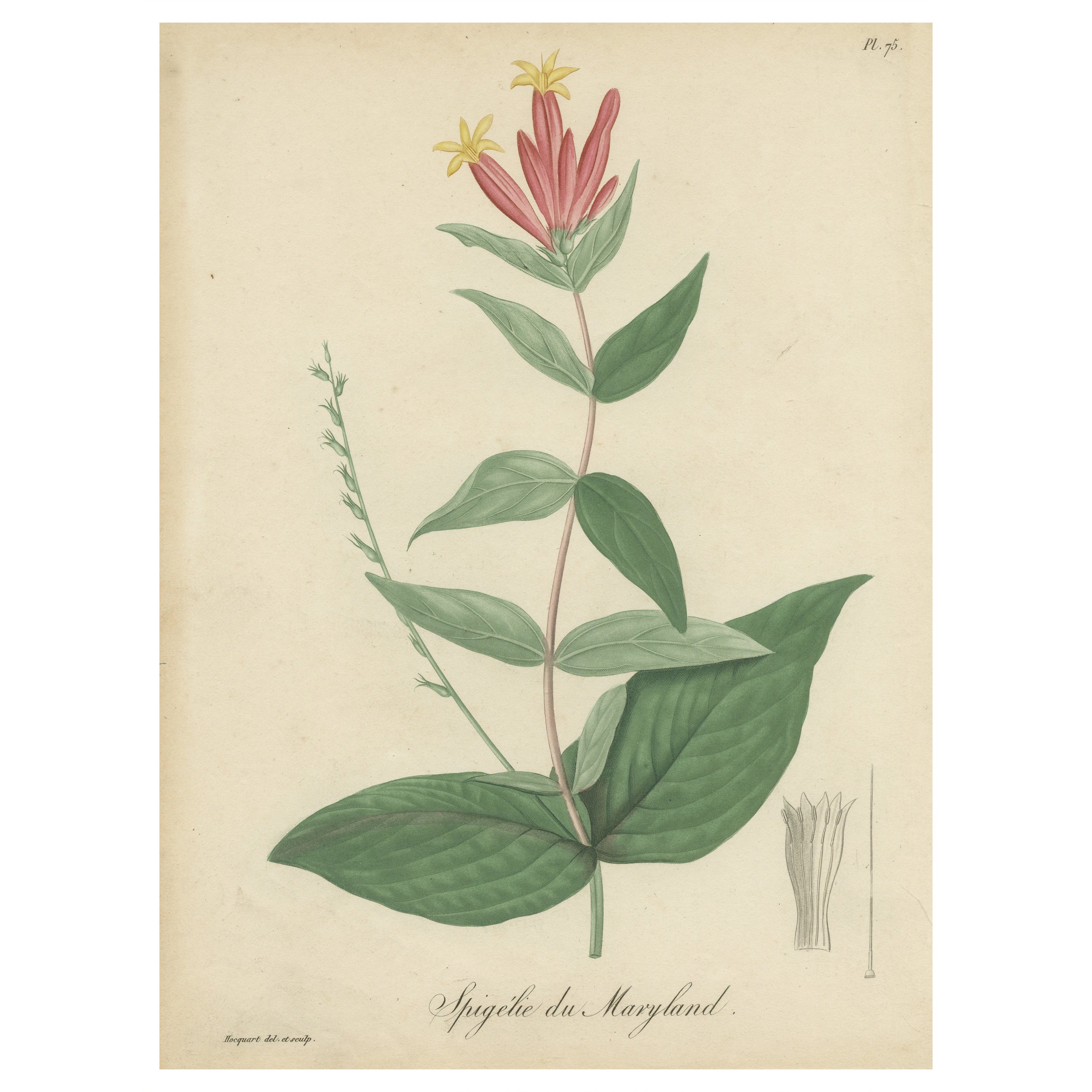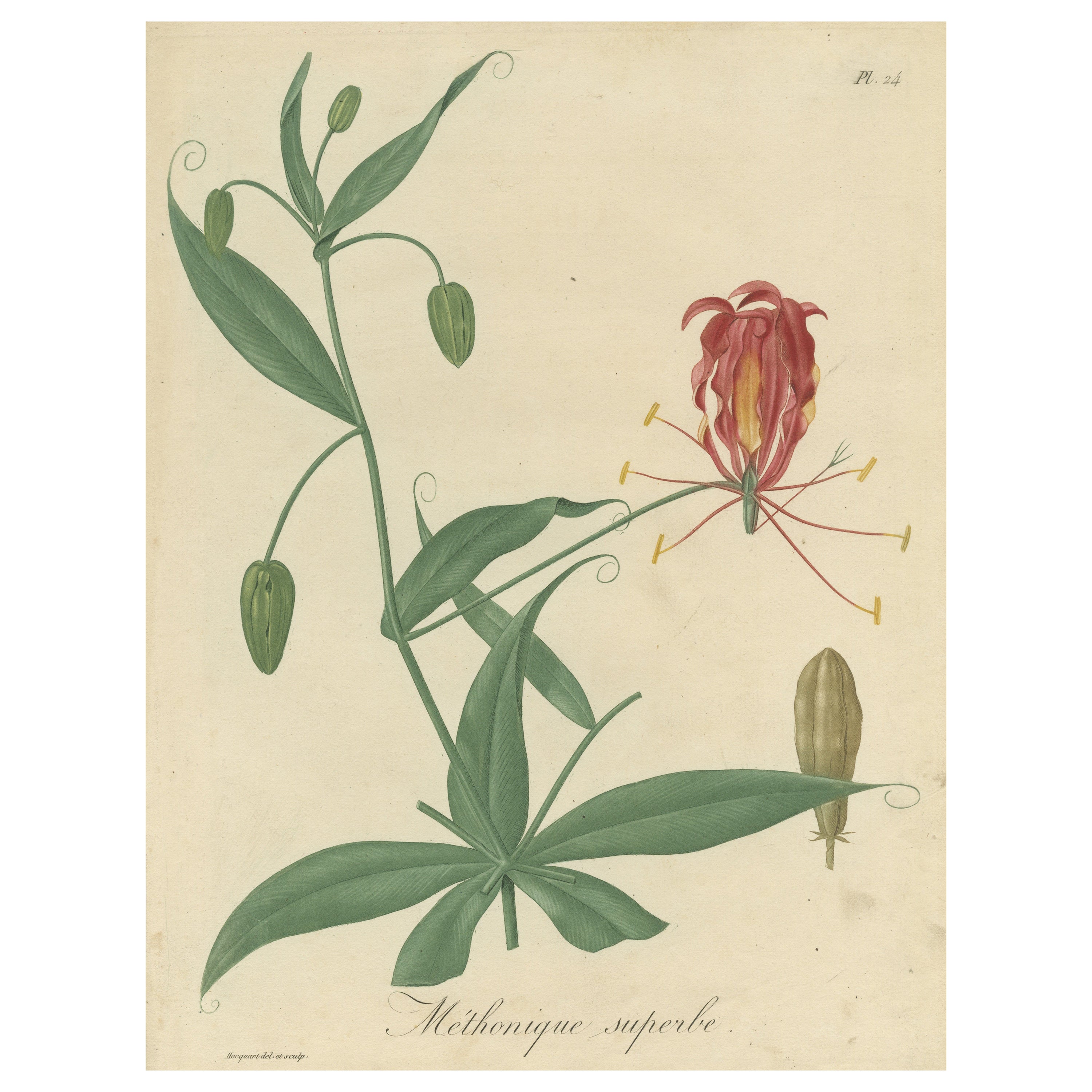Items Similar to Antique Botanical Print of Convolvulus Scammonia, or Scammony, ca.1821
Want more images or videos?
Request additional images or videos from the seller
1 of 8
Antique Botanical Print of Convolvulus Scammonia, or Scammony, ca.1821
About the Item
Antique botanical print titled 'Liseron Scammonée'. This print shows the Convolvulus Scammonia, commonly known as scammony. It is a bindweed native to the countries of the eastern part of the Mediterranean basin; it grows in bushy waste places, from Syria in the south to Crimea in the north, its range extending westward to the Greek islands, but not to northern Africa or Italy. It is a twining perennial, bearing flowers like those of Convolvulus arvensis, and having irregularly arrow-shaped leaves and a thick fleshy root. This print originates from 'Phytographie Medicale' by Joseph Roques. Engraved by Édouard Auguste Patrice Hocquart. Published circa 1821.
Édouard Auguste Patrice Hocquart (1789–1870), frequently cited as L. F. J. Hoquart, was a French publisher, writer, artist and engraver, noted for his colour plates illustrating Joseph R. Roques's (1772–1850) materia medica publication Phytographie médicale of 1821–1824.
More in detail:
The Convolvulus Scammonia, or scammony, is special for several reasons that highlight its uniqueness in the botanical world and its historical uses:
1. **Unique Habitat**: Scammony thrives in the specific climates and terrains of the eastern Mediterranean basin, from Syria to Crimea and the Greek islands. Its adaptation to bushy waste places in this particular geographic region underscores its ecological niche and specialized growth requirements.
2. **Medicinal Root**: One of the most distinguishing features of scammony is its thick, fleshy root, which has been used historically for medicinal purposes. The root contains a milky juice that, when dried, forms a gum-like substance known as scammonium. This substance has been used as a powerful purgative or laxative in traditional medicine.
3. **Twining Growth and Flowers**: Scammony is a twining perennial, which means it grows by spiraling around other plants or supports. This growth habit, combined with its flowers that resemble those of the common bindweed (Convolvulus arvensis), adds an aesthetic value to the plant. The irregularly arrow-shaped leaves further contribute to its distinctive appearance.
4. **Botanical Interest**: Its place within the Convolvulus genus, which includes a variety of species with different growth habits and ecological adaptations, makes scammony a subject of interest for botanists and plant enthusiasts. Studying its characteristics can provide insights into the diversity and evolution of plants within this genus.
5. **Historical and Cultural Significance**: The use of scammony's root in traditional medicine connects it to the cultural and historical practices of the regions where it is native. Its role in herbal medicine and the trade of medicinal plants adds layers to its significance beyond its botanical characteristics.
These aspects make the Convolvulus Scammonia a plant of interest not just for its visual beauty and ecological adaptation, but also for its historical, medicinal, and cultural significance.
- Dimensions:Height: 12.29 in (31.2 cm)Width: 8.78 in (22.3 cm)Depth: 0.02 in (0.5 mm)
- Materials and Techniques:
- Period:
- Date of Manufacture:c.1821
- Condition:Age-related toning. Shows some staining. Minor wear, blank verso. Please study image carefully.
- Seller Location:Langweer, NL
- Reference Number:
About the Seller
5.0
Platinum Seller
These expertly vetted sellers are 1stDibs' most experienced sellers and are rated highest by our customers.
Established in 2009
1stDibs seller since 2017
1,916 sales on 1stDibs
Typical response time: <1 hour
- ShippingRetrieving quote...Ships From: Langweer, Netherlands
- Return PolicyA return for this item may be initiated within 14 days of delivery.
More From This SellerView All
- Antique Botanical Print of Artemisia Absinthium or Wormwood, ca.1821Located in Langweer, NLAntique botanical print titled 'Armoise Absinthe'. This print shows the Artemisia Absinthium, also known as wormwood. It is an upright woody-based perennial with finely divided, high...Category
Antique Mid-19th Century Prints
MaterialsPaper
- Antique Botanical Print of Phytolacca Americana or American Pokeweed, ca.1821Located in Langweer, NLAntique botanical print titled 'Phytolacca à dix étamines'. This print shows the Phytolacca Americana, also known as American pokeweed, pokeweed, poke sallet, pokeberry, dragonberrie...Category
Antique Mid-19th Century Prints
MaterialsPaper
- Antique Botanical Flower Print of Spigelia Marilandica or Indian Pink, ca.1821Located in Langweer, NLAntique botanical print titled 'MSpigélie du Maryland'. This print shows the Spigelia Marilandica, also known as the Indian pink or woodland pinkroot. It is a herbacious perennial wi...Category
Antique Mid-19th Century Prints
MaterialsPaper
- Antique Botanical Print of Gloriosa Superba, Poisson Plant or Flame Lily, c.1821Located in Langweer, NLAntique botanical print titled 'Méthonique Superbe'. This print shows the Gloriosa Superba, also known as flame lily, climbing lily, creeping lily, glory lily, gloriosa lily, tiger c...Category
Antique Mid-19th Century Prints
MaterialsPaper
- Antique Botany Print of Convolvulus Cneorum by Curtis, 1799Located in Langweer, NLAntique botany print of Convolvulus Cneorum, also known as the silverbush or shrubby bindweed. This print originates from 'The Botanical Magazine; or Flower-Garden Displayed'. Arti...Category
Antique 18th Century Prints
MaterialsPaper
- Floral Elegance of the Americas: A Botanical Print of a Spigelia Species, c.1821Located in Langweer, NLAntique botanical print titled 'Spigelia Anthelminthique'. This print shows the a Spigelia species, pinkroot is a common name for plants in this genus. Spigelia is a genus of floweri...Category
Antique Mid-19th Century Prints
MaterialsPaper
You May Also Like
- Pair of Antique English Botanical PrintsLocated in Sheffield, MAPair of exceptional antique English botany prints, hand colored in Italian burl olive wood and gold leaf frames. 4 additional smaller prints available, sold separately. Great wall d...Category
Antique 19th Century English Prints
MaterialsBurl, Paper
- Original Antique Print after Thomas Rowlandson, Star Gazing. 1821By Thomas RowlandsonLocated in St Annes, LancashireGreat image by Thomas Rowlandson from the "Tour of Dr Syntax" Etching and aquatint after a drawing by Rowlandson. Published by Ackermann, dated 1821 Unframed.Category
Antique 1820s English Georgian Prints
MaterialsPaper
- Original Antique Print After Thomas Rowlandson, Card Party, 1821By Thomas RowlandsonLocated in St Annes, LancashireGreat image by Thomas Rowlandson from the "Tour of Dr Syntax" Etching and aquatint after a drawing by Rowlandson. Published by Ackermann, 1821 Unframed.Category
Antique 1820s English Georgian Prints
MaterialsPaper
- Group of Three Antique Custom Framed Botanical PrintsLocated in Bridgeport, CTA group of three Antique Botanical Prints custom framed with an interesting floating effect. The sculpted frames have an antique Creme paint finish and relate well to the muted Musta...Category
20th Century High Victorian Decorative Art
MaterialsWood, Paper
- Set of 6 Original Antique Botanical Prints, circa 1850Located in St Annes, LancashireWonderful set of 6 botanical prints Lithographs after the original botanical drawings by Hooker. Original color Published, circa 1850 Unframed. The measurement given is for one ...Category
Antique 1850s English Early Victorian Prints
MaterialsPaper
- Original Antique Print After Thomas Rowlandson, at Tulip Hall, 1821By Thomas RowlandsonLocated in St Annes, LancashireGreat image by Thomas Rowlandson from the "Tour of Dr Syntax" Etching and aquatint after a drawing by Rowlandson. Published by Ackermann, dated 1821 Unframed. .Category
Antique 1820s English Georgian Prints
MaterialsPaper





